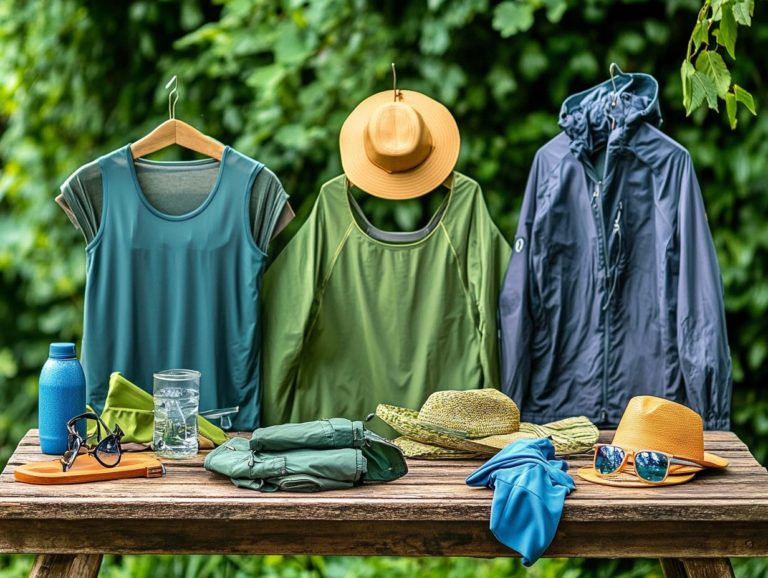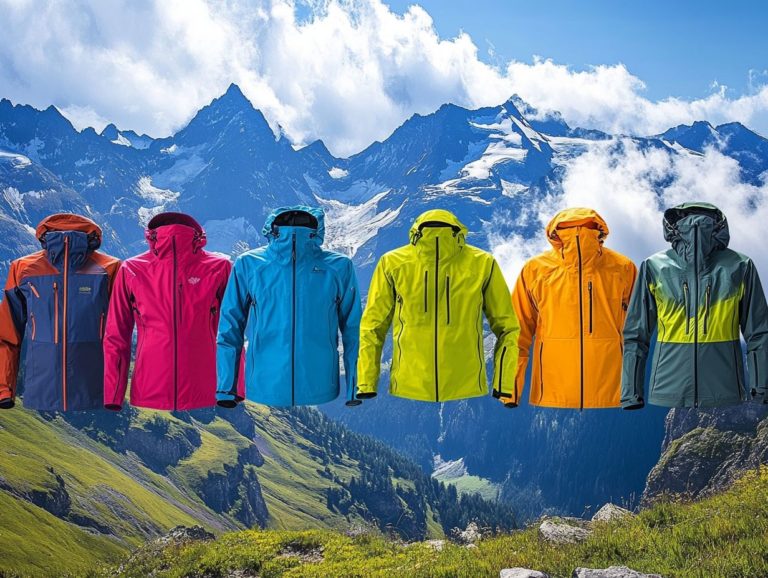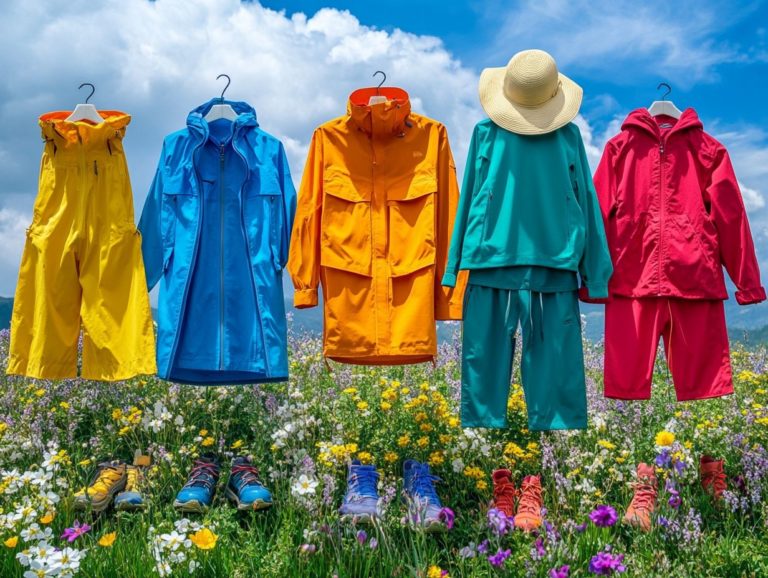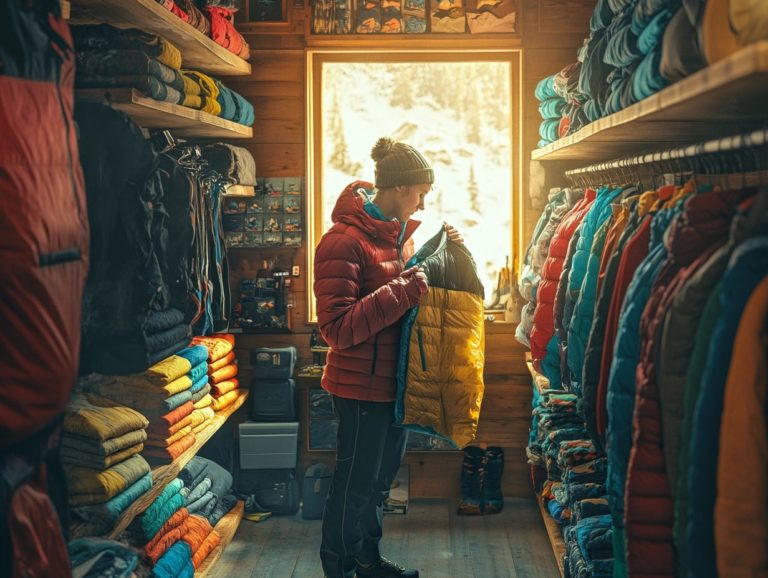Tips for Choosing the Best Outdoor Clothing Fabric
When it comes to outdoor adventures, the right clothing makes all the difference. Understanding the unique properties of various fabrics is crucial for ensuring your comfort and protection in different weather conditions.
This article delves into common materials and essential factors to consider when selecting your gear. It also covers eco-friendly options for those who want to make sustainable choices.
Get ready to discover the perfect fabric that aligns seamlessly with your needs and budget!
Contents
- Key Takeaways:
- Understanding Different Types of Outdoor Clothing Fabrics
- Factors to Consider When Choosing Outdoor Clothing Fabric
- Caring for Outdoor Clothing Fabric
- Eco-Friendly Options for Outdoor Clothing Fabric
- Tips for Finding the Best Outdoor Clothing Fabric for You
- Frequently Asked Questions
- What are some important tips for choosing the best outdoor clothing fabric?
- Is natural or synthetic fabric better for outdoor clothing?
- What is the best fabric for cold weather outdoor activities?
- Are there any eco-friendly options for outdoor clothing fabric?
- Can I choose one fabric for all my outdoor clothing needs?
- How do I properly care for my outdoor clothing fabric?
Key Takeaways:
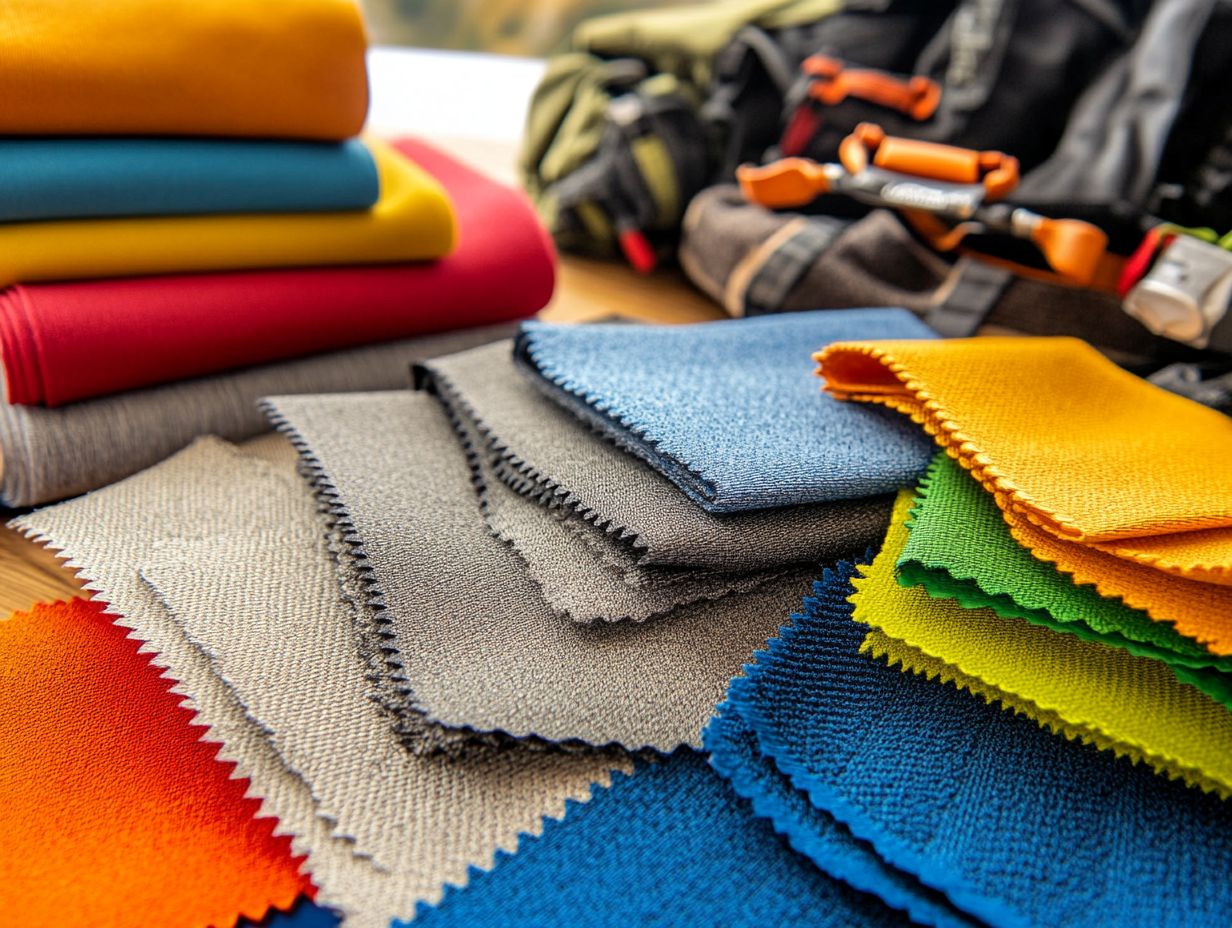
- Consider the weather and activities you will be engaging in when choosing outdoor clothing fabric to ensure it meets your needs for protection and performance.
- Look for fabrics that offer both comfort and durability to withstand harsh outdoor elements and provide long-lasting wear.
- Be mindful of eco-friendly options for outdoor clothing fabric, such as sustainable materials and production methods, to reduce your environmental impact while enjoying the great outdoors.
Understanding Different Types of Outdoor Clothing Fabrics
Understanding the various types of outdoor clothing fabrics is essential for you as an outdoor enthusiast looking to elevate your hiking experience. With a variety of materials at your disposal, including moisture-wicking fabrics that draw sweat away from your skin and a mix of synthetic and natural fibers, choosing the right hiking attire can profoundly influence your comfort, performance, and overall enjoyment during your outdoor escapades.
From the durability of polyester to the luxurious feel of merino wool, each fabric type possesses unique qualities tailored to specific outdoor conditions. This ensures optimal breathability and temperature control. Outdoor apparel is crafted with particular activities in mind, making informed choices crucial for curating the perfect hiking wardrobe.
Overview of Common Materials
Common materials used in outdoor clothing include polyester, nylon, merino wool, and cotton, each offering distinct advantages tailored to your specific outdoor activities.
Polyester is your go-to for moisture-wicking; it effectively draws sweat away from your body, making it perfect for high-energy pursuits like hiking or running. On the other hand, nylon boasts impressive durability, resisting wear and tear for those adventurers among you who demand resilience in rugged environments.
Merino wool is a standout choice for its insulation and breathability, helping to regulate your temperature and preventing overheating during strenuous excursions. While cotton may seem like a popular pick for casual wear, its tendency to retain moisture can lead to discomfort and a chilling effect in colder conditions, making it less ideal for serious outdoor enthusiasts who prioritize performance and overall comfort.
Factors to Consider When Choosing Outdoor Clothing Fabric
Selecting the ideal outdoor clothing fabric requires careful consideration of several crucial factors that can greatly influence your hiking performance and overall comfort during your adventures, particularly when facing diverse conditions.
Weather Conditions and Activities
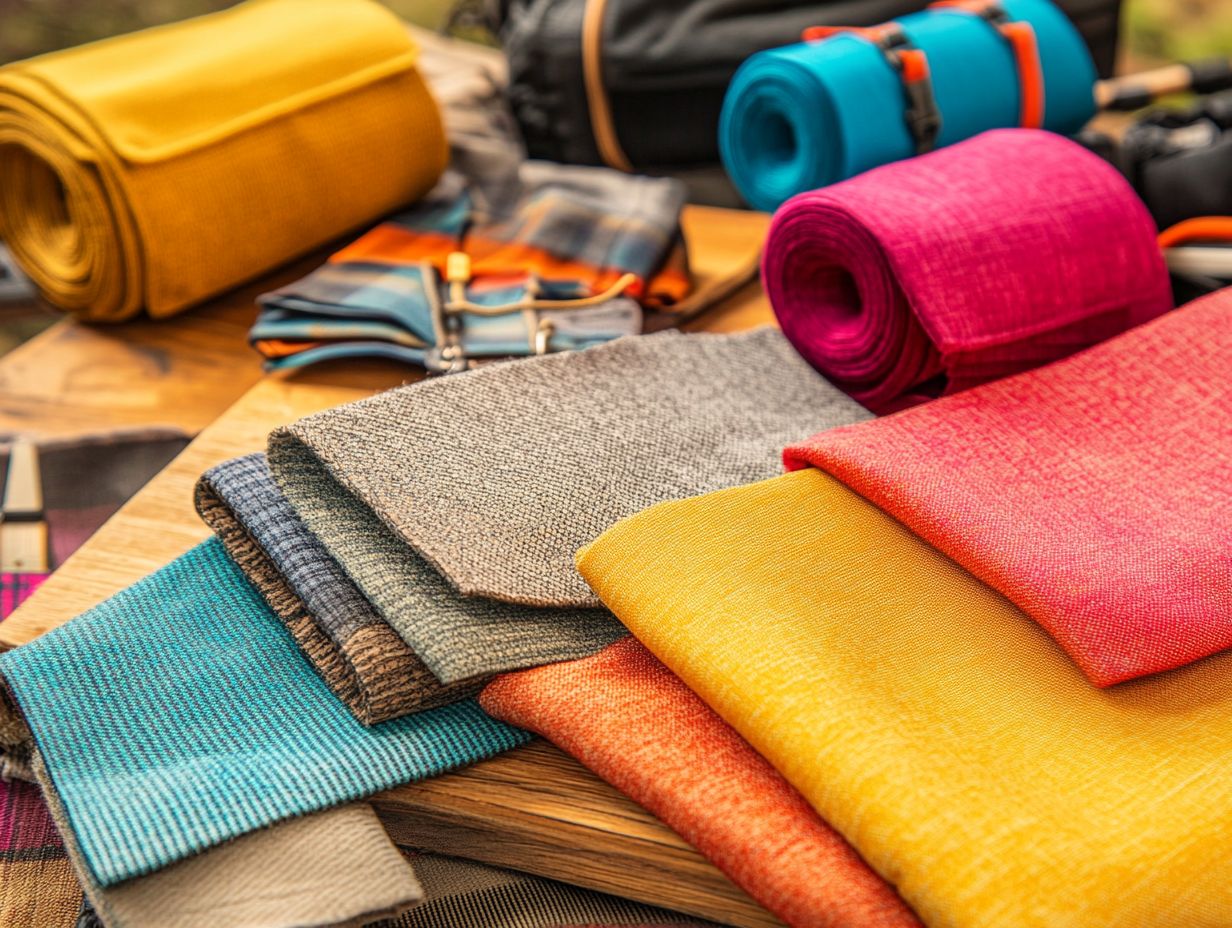
Understanding the weather conditions you ll face during your hiking adventure is key to choosing the right clothing think moisture-wicking fabrics and water-resistant materials.
In humid climates, selecting fabrics that effectively wick away moisture will keep you comfortable by minimizing sweat buildup against your skin. On the flip side, cold weather calls for materials that keep you warm while still allowing for breathability.
Layering becomes essential in both situations; each layer should play a specific role. A base layer will manage perspiration, an insulating middle layer will keep you warm, and an outer layer will shield you from wind and rain. The right combination ensures you can fully enjoy your outdoor pursuits, staying dry and comfortable no matter what the weather throws your way.
Comfort and Durability
When selecting outdoor clothing, comfort and durability should be at the forefront of your mind. These factors directly influence your hiking performance and overall enjoyment.
Choosing the right fabric can greatly enhance your comfort during outdoor activities. Fabrics that provide breathability allow sweat to evaporate rapidly, keeping you dry and helping to regulate your temperature even in sweltering conditions.
Quick-drying features are equally important. They enable your apparel to dry swiftly after encountering moisture, whether from unexpected rain or your own perspiration.
Durability is another critical aspect of outdoor apparel, especially when traversing rough terrains where wear and tear are unavoidable. If you re an active outdoor enthusiast, it’s essential for your clothing to resist wear and tear. This quality not only shields you from nature s harsh elements but also ensures your gear can withstand countless adventures with you.
Caring for Outdoor Clothing Fabric
Taking care of your outdoor clothing makes it last longer and perform better. Properly cleaning and maintaining your outdoor clothing fabric is crucial for preserving its unique properties and ensuring longevity. This attention to care enhances your outdoor experience every time you venture into nature.
Proper Cleaning and Maintenance
To extend the life of your outdoor clothing, follow the proper cleaning and maintenance practices suited to each fabric type.
For example, when it comes to merino wool, gentle washing is key think hand washing or a delicate cycle with a mild, wool-safe detergent. This approach helps preserve its natural attributes, such as moisture retention (the ability to hold moisture) and insulation (keeping you warm).
On the flip side, synthetic fibers benefit from specialized detergents crafted to enhance their performance. Committing to regular maintenance prevents damage from dirt and moisture. This ensures that the inherent qualities of the fabrics remain intact, which is crucial for maintaining comfort and protection during your outdoor adventures.
Eco-Friendly Options for Outdoor Clothing Fabric
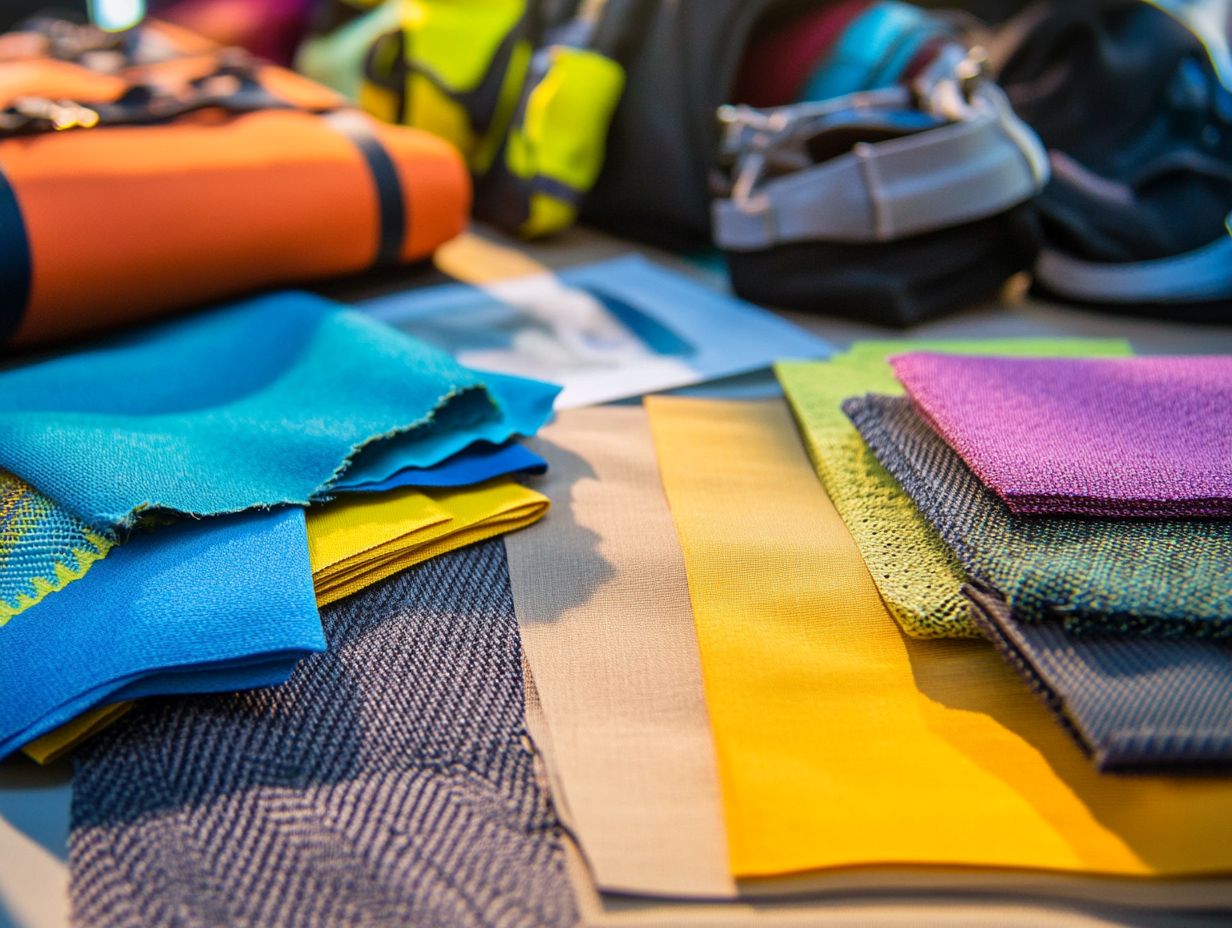
As you navigate the world of outdoor adventures, the rising tide of environmental awareness shapes your choices. Choosing eco-friendly options for outdoor clothing fabric is not just a trend; it s a responsibility that can significantly impact our planet. This guides you toward sustainable materials and responsible production methods.
Your selections not only reflect personal style but also contribute to a greater cause. Each journey becomes a testament to your commitment to the planet.
Sustainable Materials and Production Methods
Sustainable materials and production methods are leading the charge in outdoor fabrics. They offer you environmentally friendly alternatives that don t sacrifice performance.
As an outdoor enthusiast, you re likely becoming more conscious of your environmental footprint. Innovative solutions like organic cotton and recycled polyester are becoming essential. These materials not only reduce your reliance on virgin resources but also help minimize waste, reflecting the industry s commitment to a greener future.
Eco-friendly production techniques, such as low-impact dyeing and water-efficient processes, enhance the durability of fabrics while ensuring that performance remains top-notch. By embracing these sustainable practices, manufacturers cater to your demands and pave the way for a more responsible outdoor experience. This proves that style and sustainability can absolutely coexist.
Tips for Finding the Best Outdoor Clothing Fabric for You
Discovering the ideal outdoor clothing fabric that aligns with your personal preferences and budget can elevate your hiking wardrobe. This guarantees both comfort and practicality across a range of outdoor conditions.
In conclusion, choosing the right outdoor clothing fabric is vital. It not only enhances your comfort but also promotes sustainability and reflects your personal style.
Personal Preferences and Budget
When selecting outdoor clothing fabric, your personal preferences and budget play a pivotal role in enhancing your hiking performance and overall satisfaction during outdoor adventures.
Everyone has their own take on what embodies comfort, style, and functionality. These opinions will undoubtedly shape your fabric choices for hiking trips. If breathability is at the top of your priority list, you might gravitate towards fabric that pulls moisture away from your skin. On the other hand, if you’re braving the chill, insulated fabrics might be more your speed. To further enhance your outdoor experience, check out these tips for staying dry in outdoor clothing.
Get ready to explore the best outdoor apparel that meets your needs! As you search for quality clothing, it’s important to explore options across various budget ranges. Investing in durable gear from reputable brands can offer you better long-term performance. However, don’t overlook budget-friendly alternatives that deliver essential features. To make the best choice, consider what you should look for in outdoor clothing. With the right choices, you can embrace the great outdoors with both comfort and style.
Frequently Asked Questions
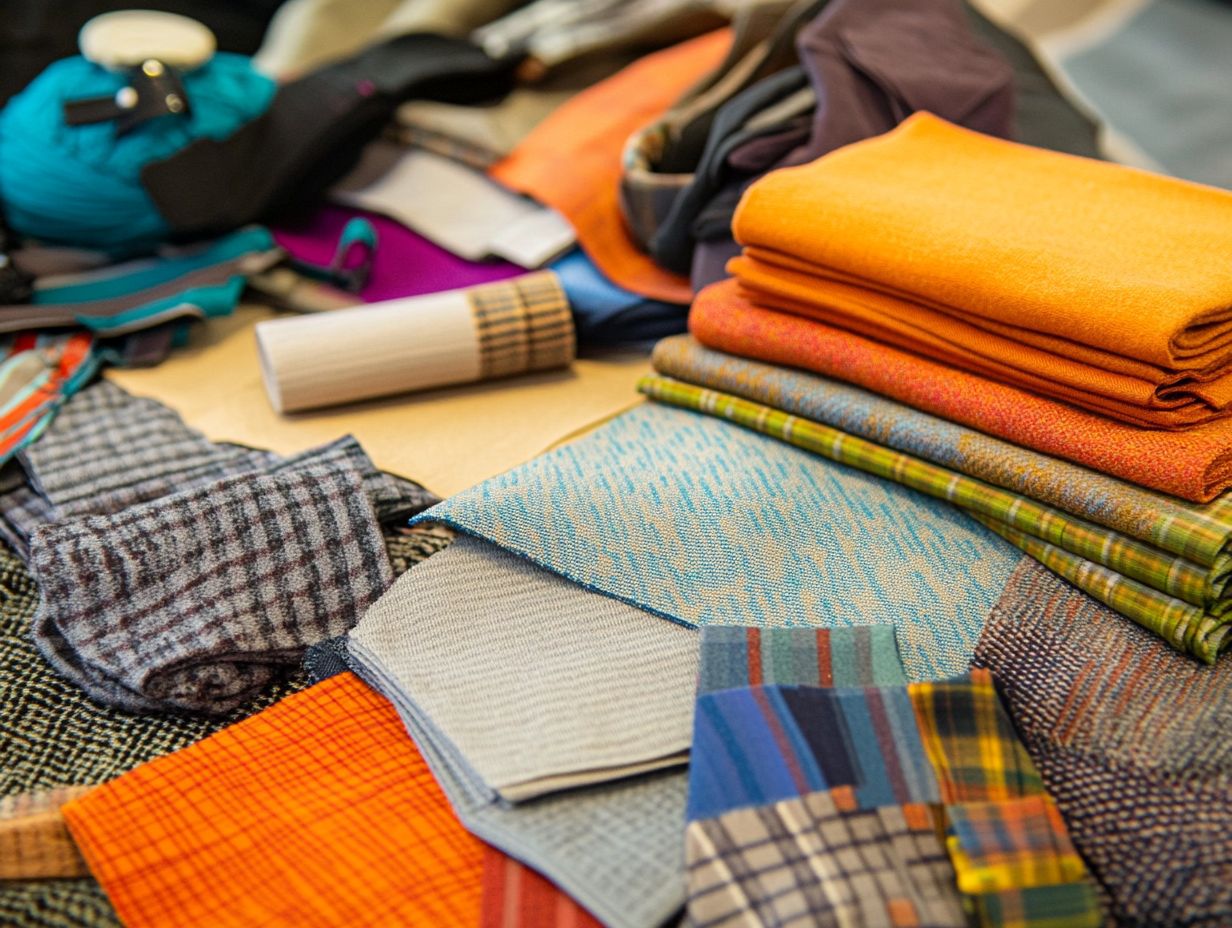
What are some important tips for choosing the best outdoor clothing fabric?
- Consider the weather: Think about the climate and conditions to select the right material.
- Moisture-wicking properties: Choose fabric that pulls moisture away to keep you dry and comfortable.
- Breathability: Look for materials that allow air to flow and prevent overheating.
- Durability: Select fabrics that can withstand wear and tear, like nylon and polyester.
- Weight: Lightweight fabrics are great for movement, while heavier ones provide warmth.
- Research fabric types: Explore options like fleece, Gore-Tex, and merino wool to find what suits you best.
Is natural or synthetic fabric better for outdoor clothing?
Both natural and synthetic fabrics have their pros and cons. Natural fibers like cotton and wool are comfortable and breathable but can retain moisture and take time to dry. In contrast, synthetic materials like polyester and nylon are lightweight and moisture-wicking, though they may lack comfort and environmental friendliness. It ultimately depends on your personal preferences and specific outdoor activity needs.
What is the best fabric for cold weather outdoor activities?
For cold weather activities, choose fabrics that provide warmth and moisture-wicking properties. Excellent options include fleece, merino wool, and Gore-Tex, known for their insulation and ability to keep you dry and comfortable in cold, wet conditions.
Are there any eco-friendly options for outdoor clothing fabric?
Yes! Several eco-friendly outdoor clothing materials are available, such as organic cotton, hemp, and bamboo. These sustainable, biodegradable options often require fewer resources compared to synthetic fabrics. Check brands that prioritize sustainability to make eco-friendly choices!
Can I choose one fabric for all my outdoor clothing needs?
It s unlikely that one fabric will suit all outdoor clothing needs. Different activities and weather conditions require various fabrics. For example, you might need a lightweight, moisture-wicking fabric for a summer hike but a heavier, insulating one for winter skiing. It s best to have a variety of fabrics in your outdoor clothing collection to prepare for all types of conditions.
Do you have any tips or experiences to share about outdoor clothing fabrics? Comment below!
How do I properly care for my outdoor clothing fabric?
To keep your outdoor clothing in great shape, always follow the manufacturer’s care instructions. Avoid fabric softener; it can harm the fabric’s ability to keep you dry and fresh.
Wash your clothes in cold water and hang them to dry. This helps prevent shrinking and keeps the fabric strong.

